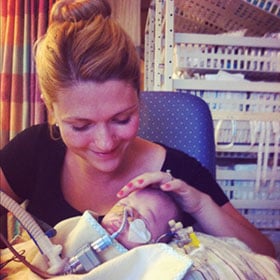SickKids contributes to best practice guidelines on caring for children with congenital diaphragmatic hernia
Summary:
SickKids has contributed to the development of best practice guidelines around a rare disorder affecting one in 2,000 to 3,000 live births: congenital diaphragmatic hernia (CDH). In cases of CDH, the internal organs in the abdominal cavity push through a weakened area in the diaphragm to travel into the chest cavity, which then interferes with lung development.
The Hospital for Sick Children (SickKids) has contributed to the development of best practice guidelines around a rare disorder affecting one in 2,000 to 3,000 live births: congenital diaphragmatic hernia (CDH). In cases of CDH, the internal organs in the abdominal cavity push through a weakened area in the diaphragm to travel into the chest cavity, which then interferes with lung development. Babies born with CDH are characterized by small lungs that make breathing difficult.
SickKids treats more CDH patients than any other centre in Canada. Partnering with the high-risk obstetrics team at Mount Sinai Hospital, they provide cutting-edge prenatal intervention and perinatal care for 20 to 25 cases per year.
Dr. Priscilla Chiu, Staff Surgeon, General Surgery, SickKids is on the steering committee of the Canadian Paediatric Surgery Network (CAPSNet), which has collected data on over 500 CDH cases since 2005. CAPSNet formed the Canadian CDH Collaborative (CCDHC), a disease-specific team of specialists to develop best practice guidelines. Dr. Martin Offringa, Staff Neonatologist, Senior Scientist and Program Head for Child Health Evaluative Sciences, SickKids and Chiu were part of the CCDHC team.
“Many centres in Canada have quite limited experience with treating CDH patients and may lack access to expert opinions or best practice guidelines,” says Offringa. “These new guidelines are the first in North America to provide recommendations for the best CDH patient care - spanning prenatal diagnosis to long-term follow up as adults.”
The guidelines were published in the January 20 edition of the Canadian Medical Association Journal (CMAJ).
Until 15 years ago, the risk of death among these infants was very high – one in two CDH patients died after birth due to severely small lungs. New advances in prenatal diagnosis, perinatal management and resuscitation have helped to improve survival but some of the children who survive continue to experience long-term health problems.

Alex Wesson learned that her son Oliver, now 5, had CDH when she was pregnant. Teams at both Mount Sinai and SickKids prepared for his delivery. Oliver was in a pulmonary and hypertensive crisis when he was born at Mount Sinai, where he was resuscitated before being transferred to SickKids. His medical team diagnosed him with a bilateral hernia. “He was worse than they expected,” says Alex. “He was a very sick little boy.”
Oliver had surgery when he was less than three weeks old. The SickKids surgical team made decisions around Oliver’s care that are now part of the best practices guidelines, such as avoiding a minimally invasive surgical approach; in cases of CDH, this type of surgery comes with a greatly increased risk of recurrence.

Oliver has healed well, according to Alex: “For the most part, he’s a perfectly normal kid with a wicked scar.” From the time he left SickKids at 70 days old he was complication-free – until this past year when he had a bowel obstruction. “It was hard on me because he had been complication-free for so long,” says Alex. She knows that because of his CDH, it is likely he will continue to have obstructions and that he also has to have heart and lung checkups on a regular basis, along with his general CDH checkup. He is also at increased risk of scoliosis, thrombosis, and of course, a reoccurrence of the hernia (as his body grows out of the repair). His parents, teachers and caregivers are always vigilant for emergency symptoms.
Says Chiu: “Patients with CDH, like Oliver, will require complex, interprofessional care at every life stage. These new guidelines will give their care teams the tools to provide the best care based on the most recent evidence, and hopefully, give their families more peace of mind.”

